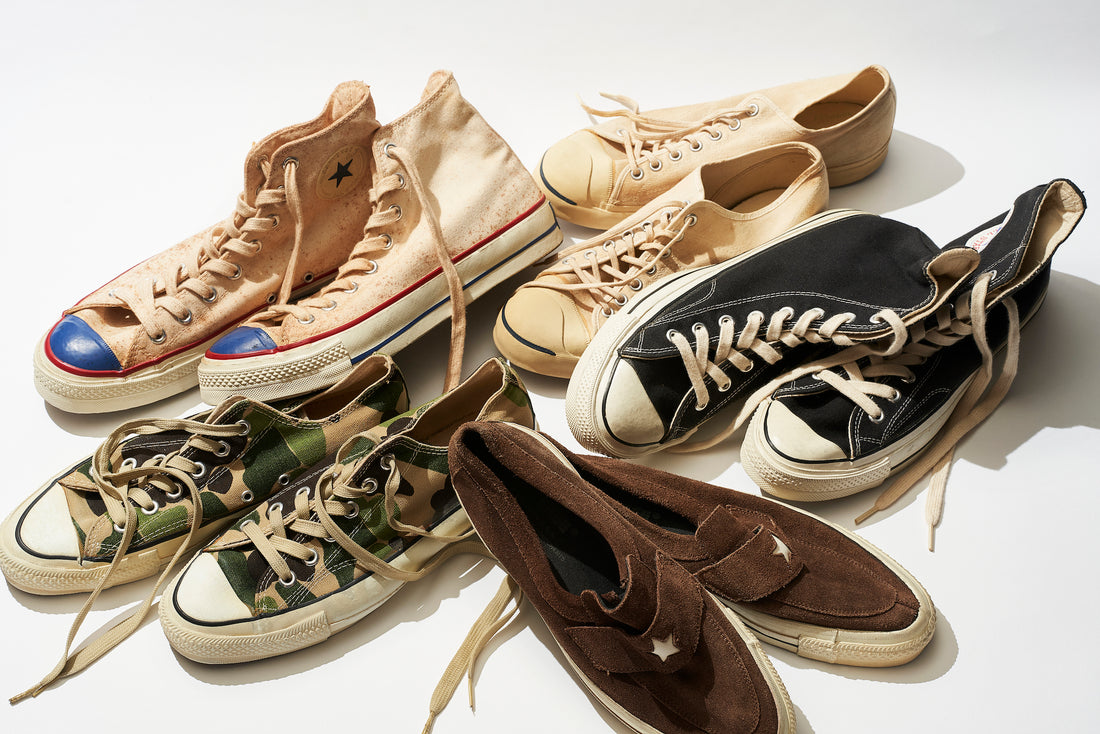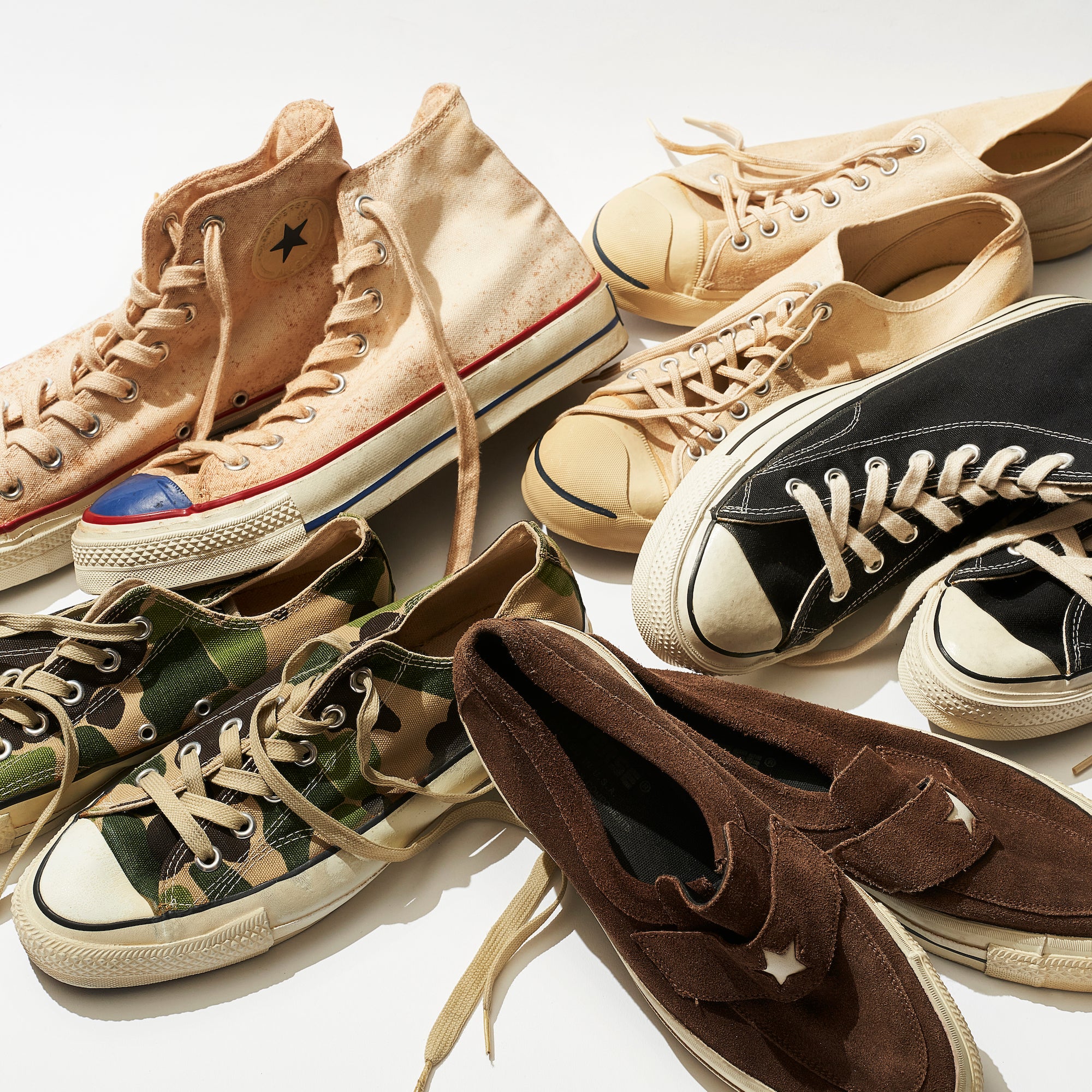Vintage Clothing Prep School Lecture 2: Converse, the world's best-selling sneaker, with a history spanning more than 100 years since its birth.
Lecturer: Michihiko Kurihara




Mr. Clean Representative
Born in 1977, he built his career at the famous Lost Hills store in Harajuku, and began working as a freelance buyer in 2011. He spends about half the year buying in the US, and is a world-renowned vintage buyer who has earned the trust of many with his industry-leading aesthetic sense and overwhelming knowledge of both new and old items. His personal collection is not limited to Converse, but also includes a wide range of items such as outdoor and military wear. He also has his own shop, Mr. Clean, in Oku-Shibuya.
Instagram: @michihikokurihara
During the first vintage boom in the 90s, shoes made before the 70s that had heel patches other than the All Star designation, such as Converse Chuck Taylors and Coach shoes, were considered vintage. But when did American-made All Stars in general start to be considered vintage?
When I went to America for the first time to buy in 1996, most of the in-line models were still made in America, and even the so-called "silver boxes" from the 80s to early 90s were sold cheaply, except for some models with different materials or patterns such as camouflage. When the current models were still made in America and new ones were sold for several thousand yen, no one went out of their way to buy used ones at thrift stores. Later, when American-made ones disappeared, they were put up for clearance sales at mass retailers in Japan. People with foresight bought them up at that time, and later sold them when they became rare as dead stock and became expensive. I think that from around the end of the 2000s, when it became difficult to find American-made ones even used, they gradually started to be treated as vintage.

That being said, it's not like there was an announcement in advance that Converse's production base would no longer be located in the United States.
Some people in the industry may have known about it beforehand, but I remember hearing about it through word of mouth around the time production shifted from the US to other countries. However, other brands were also gradually moving their production bases to Asia and other places, so I think it was predicted to some extent.
When did production move to other countries?
I think I mentioned this before when we did a special order project for Converse by Vintage Summit, but there are American-made models called All Star C-2001 and All Star 21, so it seems that they must have been selling some American-made products at least until 2001.
That means it must have been after 2000. Apart from the shift in production bases, have you seen any other factors that caused a resurgence or price hike?
Up until then, low-cut Chuck Taylors and All Stars were the mainstream, especially in the vintage scene, but in the mid-to-late 2000s, black high-cut shoes started to gain attention due to the influence of stylist Tsuyoshi Noguchi and other people who were popular with fashionable people. Since then, with the exception of a few models, it seems that high-cut shoes have become more popular and more expensive than low-cut shoes.

Even in the United States, the number of eggs is decreasing year by year.
That's right. Until the end of the 90s, deadstock 80's All Stars would still come out at the Rose Bowl quite often, and in 1999 I found and bought a hundred pairs of black shoes in a silver box in the warehouse of a military shop in Texas, but by the 2000s, deadstock shoes from before the 80s were rarely found. Then, in the late 2000s, Japanese buyers started looking for deadstock shoes made in the US from the 90s onwards that had been lying dormant in the US, and now there is demand for them not only in Japan but also around the world, so when it comes to deadstock Chuck Taylors, they are becoming scarce, to the point where you might find one pair every few years. Also, there is a high demand for good quality used sneakers in Mexico, which borders the US, so I think there are many vintage shoes that have been collected by them.
Demand for American-made Jack Purcell watches seems to have increased rapidly in Thailand since the mid-2010s, and demand from other countries is also spurring the surge.
That's right. Until then, the global market was based on Japan, but after the price surge in Thailand, its influence became greater, and deadstock Jack Purcells from before the 70s in navy or black, which are particularly popular among Jack Purcells (those with the toe cap and the top of the side tape the same color as the upper), went from under 100,000 yen in the 2000s to around 400,000 to 600,000 yen at present.
Is this also resonating with the younger generation in America?
Of course, they are sold as merchandise for the Japanese market, but you hardly ever see Americans wearing old sneakers. Even the hardcore vintage people who frequent the Rose Bowl mostly wear boots or current sneakers. In fact, there is almost no market for vintage sneakers. Until the late 2000s, Mexican dealers would bring vintage sneakers they collected in Mexico to flea markets in LA, such as the Rose Bowl or Rhodium, and use the proceeds to buy beautiful used sneakers to take back to Mexico, but these dealers could no longer make enough profit from vintage sneakers and all went out of business. There are fewer sneakers from before the 1990s compared to clothing, and even if they are found, they cannot be sold for the high prices they did during the 1990s boom, so there are almost no dealers who spend time and money collecting vintage sneakers. The center of the used sneaker market in the United States is not vintage, but hype sneakers such as Jordans and Yeezys from the 2010s onwards.

Given all this, what is it that makes All-Star games so special around the world?
While most old sneakers cannot be kept in wearable condition due to hydrolysis, hardening of rubber, and other deterioration over time, classic Converse models such as All Stars and Jack Purcells are still in demand because they rarely become unwearable due to such deterioration. Of course, they do deteriorate, but while other companies' sneakers from the same era become unwearable due to hardening of the outsole or, conversely, softening, Converse models almost never reach that level. However, this is one thing to check when purchasing shoes, but there is a phenomenon that is often seen in models from the 1980s to the early 1990s, especially All Stars from the 1980s, where the material used in the insole hardens and loses its cushioning, sinking and turning into powder as you wear them. Moreover, in most cases, this symptom occurs only in one foot, not both. Therefore, when purchasing the above models, we recommend that you check both feet carefully to make sure that the surface of the insole is not hardened.
Are there a fair number of items that are not made in the US but are already considered vintage, in other words, "deemed vintage"?
Like other companies, Converse has been producing models made outside of the US since the late 70s. For example, they have Korean canvas All Stars and suede, leather Coach and Jack Purcell, and Yugoslavia Pro Leather. Strictly speaking, made in the US does not necessarily mean vintage. However, I think that there are no vintage models produced after the 2000s when they stopped producing in the US.
Converse, which was founded in 1908 as the Beacon Falls Rubber Company in Massachusetts, initially produced rubber shoes that could be worn during the snowy winter months. The company then turned its attention to basketball, which had just been invented as a main sport during the off-season, and released the All-Star in 1917, the world's first basketball shoe, which is still in production today. Here are five models that Kurihara selected from the archives of this prestigious company.

Converse, which focused on basketball and was invented by Dr. James Naismith, who was a member of the YMCA at the time, developed the world's first court model in 1917. In honor of Charles H. Taylor, who loved the excellent quality of the shoe and wore it for many years during his active career, his name has been inscribed on the ankle patch since 1946. This model is a 70s high-cut model with a black heel patch, an icon of the Chuck Taylor era. The low-cut model began to be manufactured in 1957.

The All Star Trainer, which was released in 1959, is a rare model that, as its name suggests, has a weight installed under the insole, and was developed with the aim of increasing muscle strength by applying physical stress to both feet. The heel label has a diagonal three-star design that was used until 1962 (it changed to a horizontal three-star design from 1963), and the blue toe cap is also an icon of this model. Although I got it as dead stock, the weight has changed over the years, causing spots to appear on the upper.

The camouflage patterned All-Star was featured in Takarajima magazine's serial "LAST ORGY 2" and became popular in the 90s. In fact, it was the first patterned All-Star in history to be released in 1983. Until then, All-Stars had only been available in solid colors such as team colors, but starting with this model, various patterns such as flags of all nations, American flags, flannel checks, animal patterns, etc. were introduced, and they became more closely associated with fashion and youth culture.

This rare model was not well received when it was released, and Kurihara managed to get a deadstock copy for just a few thousand yen a few years later. A redesigned version of the model that retained the iconic Converse design was released in the late 90s, and in later years it gained a high reputation in the vintage market as a rare type of Converse. The One Star Loafer is particularly popular, and was recently reissued by Converse Addict, which became a hot topic.

This is a veteran signature model known for having been developed with the participation of badminton player Jack Purcell, who won the World Championship for 14 consecutive years from 1932. It was first released by AG & Spalding, and from the 1940s onwards it was manufactured by BF Goodrich. In the 1970s the company merged with Converse's shoe division. This model was made by BF Goodrich around the 1940s. It has no heel patch, double outstitching on the sides, and also features the posture foundation insole, which is the identity of this model. Although this model was not made by Converse, it is the oldest Jack Purcell model owned by Kurihara, so we have featured it here.
Address: 1F Settle MS Yoyogi Park, 1-35-4 Tomigaya, Shibuya-ku, Tokyo
Phone: 090-2206-1755
Instagram: @mrcleantomigaya